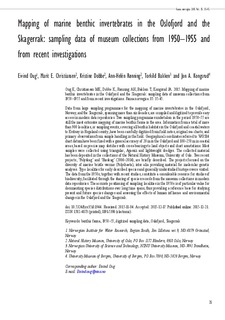| dc.description.abstract | Data from large sampling programmes for the mapping of marine invertebrates in the Oslofjord, Norway, and the Skagerrak, spanning more than six decades, are compiled and digitized to provide easy access in modern data repositories. Two sampling programmes undertaken in the period 1950–55 are still the most extensive mapping of marine benthic fauna in the area. Information from a total of more than 900 localities, or sampling events, covering all benthic habitats in the Oslofjord and coastal waters to Kvitsøy in Rogaland county, have been carefully digitized from field notes, original sea charts, and primary observations from sample handling in the field. Geographical coordinates referred to WGS84 chart datum have been fixed with a general accuracy of 20 m in the Oslofjord and 100–250 m in coastal areas, based on precise map sketches with cross-bearings to land objects and chart annotations. Most samples were collected using triangular, Agassiz and lightweight dredges. The collected material has been deposited in the collections of the Natural History Museum, University of Oslo. Two recent projects, ‘Polyskag’ and ‘Bioskag’ (2006–2014), are briefly described. The projects focused on the diversity of marine bristle worms (Polychaeta), inter alia providing material for molecular genetic analyses. Type localities for early described species and generally understudied biotopes were visited. The data from the 1950s, together with recent studies, constitute a considerable resource for studies of biodiversity, facilitated through the sharing of species records from the museum collections in modern data repositories. The accurate positioning of sampling localities in the 1950s is of particular value for documenting species distributions over long time spans, thus providing a reference base for studying present and future species changes and assessing the effects of human influence and environmental changes in the Oslofjord and the Skagerrak. | nb_NO |

